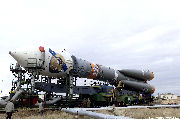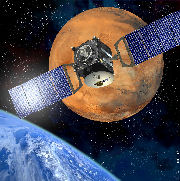








|
The
Mars Express mission
Mars Express, so called because of the rapid and streamlined
development time, represents ESA's first visit to Mars. The spacecraft
borrows technology from the failed Mars 96 mission and from ESA's
Rosetta mission. The mission helps to answer fundamental questions
about the geology, atmosphere, surface environment, history of water
and potential for life on Mars. The
journey to the red planet began on 2 June 2003 with the
launch from the Baikonur Cosmodrome on a Soyuz-Fregat rocket. It
ended on 25 December 2003 with the successful orbit insertion. Mars
Express opened a new era for Europe in planetary exploration. Mars
Express has a lander (Beagle 2, built in the UK), the lander designed
to perform exobiology and geochemistry research. Although the lander
failed to land safely on the Martian surface, the orbiter has been
successfully performing scientific measurements since early 2004,
namely, high-resolution imaging and mineralogical mapping of the
surface, radar sounding of the subsurface structure down to the
permafrost, precise determination of the atmospheric circulation and
composition, and study of the interaction of the atmosphere with the
interplanetary medium. The total mass budgeted for the science payload
is 116 kg..
- Analyzer of Space Plasmas and Energetic Atoms (ASPERA,
Sweden) -
Investigates interactions between upper atmosphere and solar wind. Is
mounted on the top face.
- High Resolution Stereo Camera (HRSC, Germany) - Produces
color images
with up to 2 m resolution. Is mounted inside the spacecraft body, aimed
through the top face of the spacecraft, which is nadir pointing during
Mars operations.
- Sub-Surface Sounding Radar Altimeter (MARSIS, Italy) - A
radar
altimeter used to assess composition of sub-surface aimed at search for
frozen water. Is mounted in the body and is nadir pointing, and also
incorporates the two 20 m antennas.
- Mars Express Lander Communications (MELACOM, UK) - Allows
Mars
Express to act as a communication relay for landers on the Martian
surface.
- Mars Radio Science Experiment (MaRS, Germany) - Uses radio
signals to investigate atmosphere, surface, subsurface, gravity and
solar corona density during solar conjunctions. It uses the
communications subsystem itself.
- Visible and Infrared Mineralogical Mapping Spectrometer
(OMEGA, France) - Determines mineral composition of the surface up to
100 m resolution. Is mounted inside pointing out the top face.
- Planetary Fourier Spectrometer (PFS, Italy) - Makes
observations of atmospheric temperature and pressure (observations
suspended in September 2005). Is mounted inside pointing out the top
face and is currently working.
- Ultraviolet and Infrared Atmospheric Spectrometer (SPICAM,
France) -
Assesses elemental composition of the atmosphere. Is mounted inside
pointing out the top face.
Our engineers developed the EGSE for SPICAM instrument. SPICAM
(Spectroscopy for Investigation of Characteristics of the Atmosphere of
Mars) is an imaging spectrometer for ultraviolet and infrared
radiation. SPICAM is equipped with two channels, one for ultraviolet
wavelengths and one for infrared.
24.
December
2014
|

Mars
Express
integration in ESTEC

Mars
Express on Sojuz/Fregat
rocket

Mars
Express at
Mars (Artwork)
|


